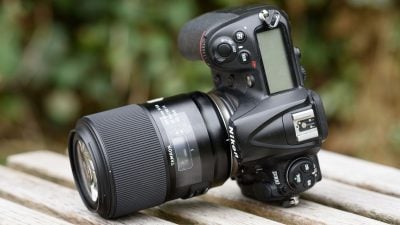Tamron 90mm f2.8 VC II review
-
-
Written by Thomas
Quality
Longitudinal Chromatic Aberration and focus shift
With lenses offering an aperture of f2.8 or larger I test for longitudinal CA (loCA, a.k.a. “axial color” or “bokeh CA”). The new Tamron shows some magenta coloration in the foreground (left) and somewhat weaker greenish hues in the background (right). By f5.6 the effect is gone. The lens showed no discernible focus shift.
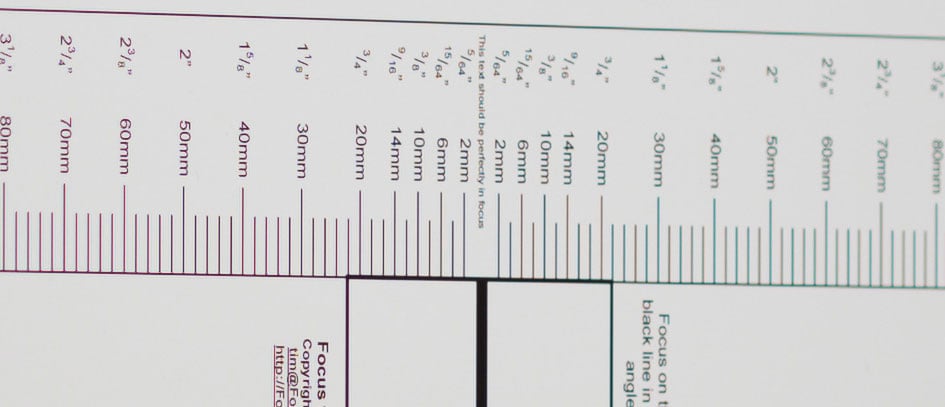
Above: Tamron 90/2.8 VC ii Longitudinal Chromatic Aberration (loCA) at f3.0. 100% crop, left = foreground, right = background
The loCA also shows up in real-life shots like in the following high contrast situation. The difference between the left crop and the right is just a bit different focus. Both images were developed to the same white balance:

Above: Tamron 90/2.8 VC ii loCA at f2.8. 100% crop, left = focus behind tree, right = focus in front of tree
As this is a macro lens I also tested the effect at a distance of 0.5m resulting in a magnification of about 1:3.3. Following is a 50% crop:
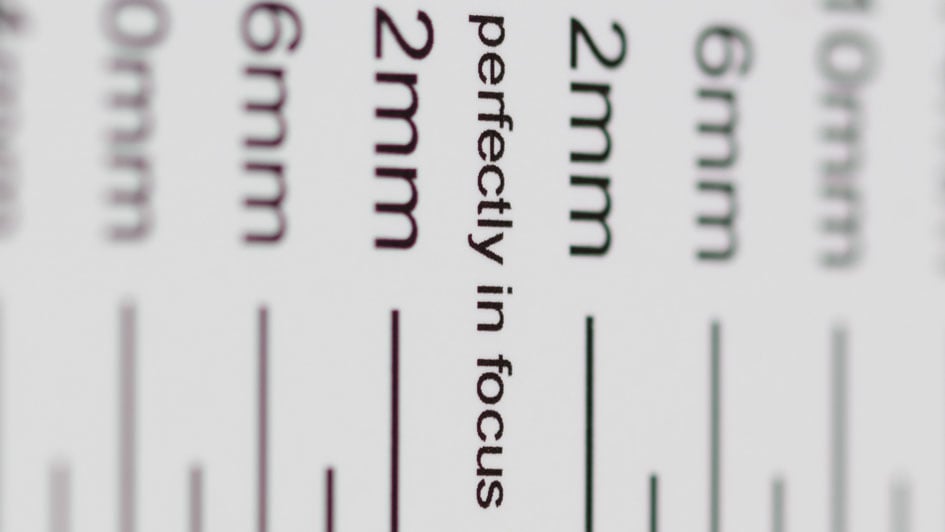
Above: Tamron 90/2.8 VC ii loCA, 1:3.3 magnification, f4.0, 50% crop; also available at f5.6, f8.0, f11, f16
At larger magnifications loCA is not too obvious. The Nikon 105/2.8 VR Micro Nikkor shows a stronger coloration in comparison:
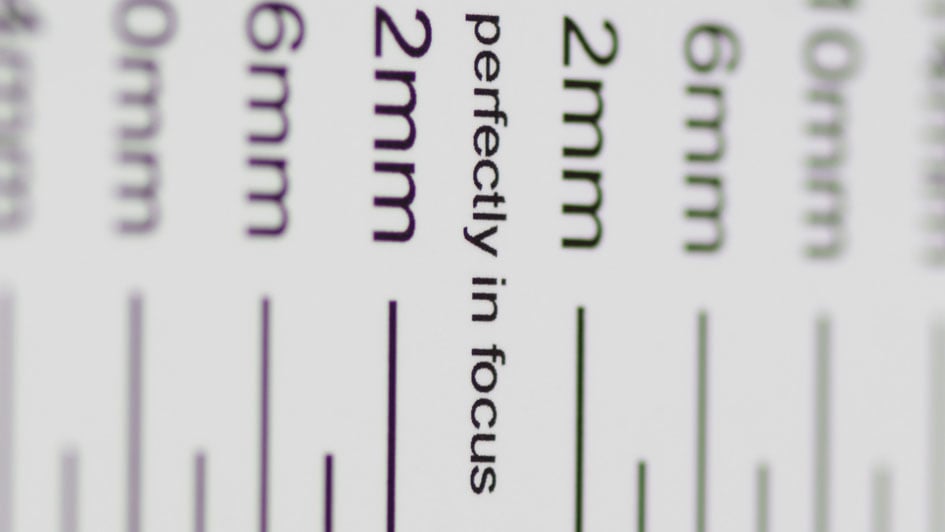
Above: Nikon 105/2.8G VR loCA, 1:3.3 magnification, f4.0, 50% crop; also available at f5.6, f8.0, f11, f16
Sharpness and contrast
Let’s have a look at the theoretical performance of the new lens first compared to the Nikon 105/2.8 VR Micro Nikkor:
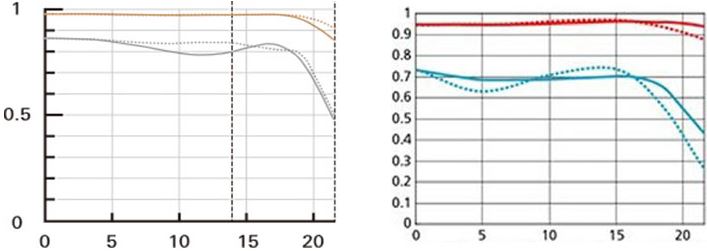
Above left: Tamron 90/2.8 VC ii MTF at f2.8, right: Nikon 105/2.8G VR MTF at f2.8
These charts show the lens-performance at the largest aperture. Higher values are better and the closer the dotted and the continuous lines of each color are together the less astigmatism (= resolution depends on the orientation of the test-pattern) the lens has. The x-axis displays the distance from the optical axis (=center of the sensor) in mm. I’ll show you the real-life performance at 4 mm (center), 13 mm (APS-C/DX-corner), and 20 mm (FF/FX-corner) on a D810.
From the charts, the new Tamron should perform better than the Nikon: The level of its contrast at 30 line-pairs per mm (gray line) runs significantly higher than the respective petrol-colored lines of the Nikon. Both lenses show a marked decline in resolution in the last 2mm of the FF/FX-corner. But let’s see how this theoretical performance translates into real life results in the sharpness test based on Siemens-stars.
What follows are near-center results (first column) followed by APS-C/DX-corner results and FF/FX-corner results on a D810. Processing was done in Lightroom 6.4 from RAW at Camera Standard settings. Noise-reduction is set to 0, sharpening to 35/0.5/36/10, with no extra tone, color, or saturation-adjustment. White-balance was adjusted to a neutral white and I did some exposure compensation to make the brightness of all crops match. So you will not see light fall-off in the corners. CA-removal is ON. At the test distance of 3.6m the focal ratio of the lens is reduced a bit from f2.8 to f3.0.
The following are all 100% crops!
Tamron 90/2.8 Macro VC ii; 100% crop from center, APS-C/DX-corner, FF/FX-corner

Above: 90mm, f3.0

Above: 90mm, f4.0

Above: 90mm, f5.6

Above: 90mm, f8.0

Above: 90mm, f11

Above: 90mm, f16
These 100% crops directly from a 36MP D810 sensor show that this lens delivers a very good performance across a full-frame sensor right from the start. The DX-crop needed a slightly different focus but differences were minimal: proof that the lens has almost no field-curvature to speak of. Coma seems well under control in the FX-corner. Stopping down to f4.0 gives the lens even more “bite” and at f5.6 performance is perfect. Diffraction sets in at f11.
Following is the performance of the Tamron 90/2.8 Macro VC ii at f3.0 (1st row) directly compared to the Nikon 105/2.8G VR (2nd row) and the predecessor (model F004) of the new Tamron (last row) at f2.8:

Above: Tamron 90/2.8 Macro VC ii at 90mm, f3.0

Above: Nikon 105/2.8G VC at 105mm, f2.8

Above: Tamron 90/2.8 Macro VC (F004) at 90mm, f3.0
The performance of all three lenses is pretty similar with a slight advantage for the old and new Tamron within the APS-C/DX image circle and a clearer advantage in the FF/FX-corner over the Nikon.
Performance at large distances
The Siemens-star test-targets are shot at a distance of 40x focal length (i.e. at 3.6m for 90mm focal length). But performance of lenses also depends on the shooting distance. Therefore I present another series of test-shots of a landscape dubbed the “Unremarkables” where you can measure distances in km, not meter. Processing was done in Lightroom 5.7.1 from RAW at Adobe Standard settings. Noise-reduction is set to 0, sharpening to 35/0.5/36/10, with no extra tone, or saturation-adjustment. There’s no tinkering with vignette-control so you see it here as it is produced by the lens. Focus was acquired at the largest aperture manually and not changed for other apertures.
You can click on each image to access the large original. Please respect our copyright and only use those images for personal use.
The main image shows the complete scene at f2.8 to give you an impression of the angle of view and to judge vignetting. This is followed by one row of 100% crops at different apertures each from near the middle, the DX/APS-C-corner, and the FX/FF-corner. You can access the respective shots via the images.
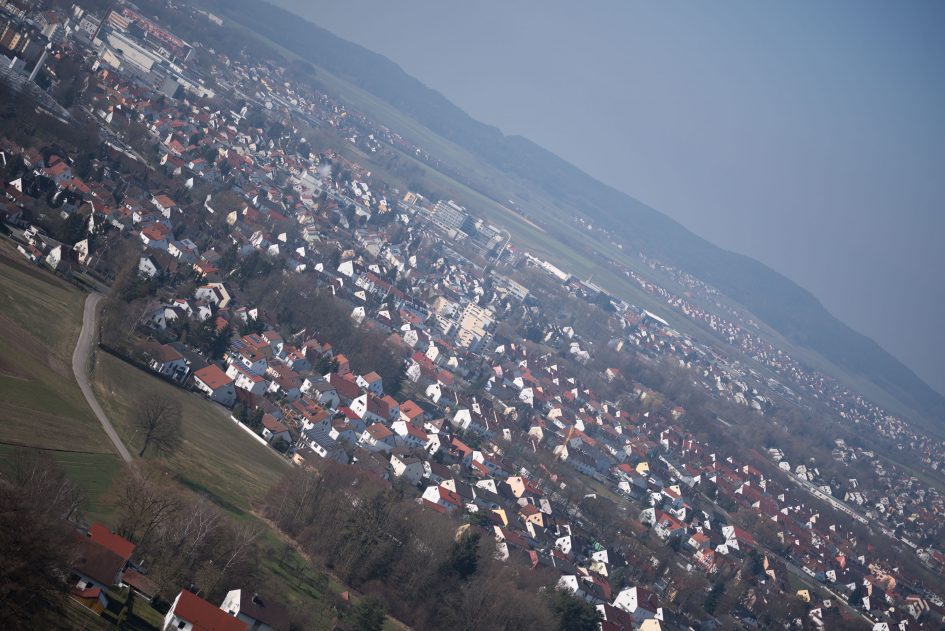
Above: Tamron 90/2.8 VC ii at f2.8

Above: Tamron 90/2.8 VC ii at f2.8; 100% crop from center, APS-C/DX-corner, FF/FX-corner

Above: Tamron 90/2.8 VC ii at f4.0; 100% crop from center, APS-C/DX-corner, FF/FX-corner

Above: Tamron 90/2.8 VC ii at f5.6; 100% crop from center, APS-C/DX-corner, FF/FX-corner

Above: Tamron 90/2.8 VC ii at f8.0; 100% crop from center, APS-C/DX-corner, FF/FX-corner

Above: Tamron 90/2.8 VC ii at f11; 100% crop from center, APS-C/DX-corner, FF/FX-corner

Above: Tamron 90/2.8 VC ii at f16; 100% crop from center, APS-C/DX-corner, FF/FX-corner
Atmospheric conditions were not the clearest on that day but you can still see that the very good performance from the star-charts translates to a similar performance at long distances. Stopping down to f4 improves acuity in the center a bit and lessens the light fall-off in the FF/FX-corner. And don’t stop down beyond f8 as you can already see the loss in contrast due to diffraction at f11.
Following is a comparison at f2.8 with the Nikon 105/2.8G VR (2rd row) shot only a few minutes apart. I also shot the predecessor of the new Tamron (model F004) a few days later at similar conditions but had to use another corner as the lens was mildly decentered (3rd row):

Above: Tamron 90/2.8 VC ii at f2.8; 100% crop from center, APS-C/DX-corner, FF/FX-corner

Above: Nikon 105/2.8G VR at f2.8; 100% crop from center, APS-C/DX-corner, FF/FX-corner

Above: Tamron 90/2.8 VC (F004) at f2.8; 100% crop from center, APS-C/DX-corner, FF/FX-corner
The Tamron F004 was a bit decentered so I had to use the other diagonal for these crops. The images are also available at f4.0, f5.6, f8.0, f11, f16, f22. The Nikon 105/2.8G VR images are also available at f4.0, f5.6, f8.0, f11, f16, f22.
Compared to the Nikon the new Tamron shows the better performance across the sensor while the older Tamron F004 model is the weakest in this comparison – albeit not by a large margin.
All-in-all the new Tamron 90/2.8 Macro VC ii is a very good performer at the usual distances. So it can not only be used for macro work but easily doubles as a very good light tele-photo lens for general purpose shooting.
Rendering of point-light sources at night-shots
Night-shots pose a different challenge for lenses as the contrast is even higher than under bright sun and point-light sources can reveal some weaknesses such as coma, haloing and color-aberrations that do not show up as prominently in other test-shots. The 100% crops below the main image show the effect of coma in the FF/FX-corner of this lens at various apertures:
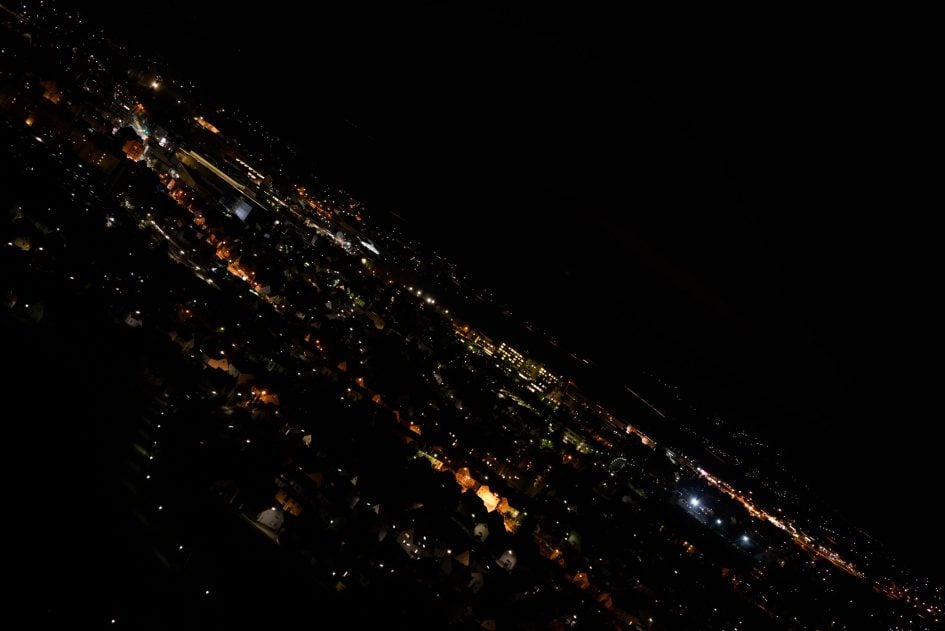
Above: Tamron 90/2.8 VC ii at f2.8

Above: Tamron 90/2.8 VC ii; FF/FX corner at f2.8, f4.0, f5.6
As demonstrated in the other tests above the lens has indeed a very good correction for coma. This is responsible for the very good resolution in the FF/FX-corner. Stopping down does not improve the already good performance but increases the flare of point-light sources. This is due to the effect of the FF/FX-corner becoming brighter and star-bursts already developing at f4.0.
Following is the Nikon 105/2.8G VR shot only a few minutes apart.

Above: Nikon 105/2.8G VR; FF/FX corner at f2.8, f4.0, f5.6
The Nikon also has minimal coma with a slightly different signature from the Tamron. And there’s a similar effect of increasing flare when stopping down.
Rendering of out-of-focus point-light sources
This test is for the rendering of point-light sources in an out-of-focus background. The circle of confusion that is produced by this test is pretty indicative of Bokeh performance (in the background) and light fall-off. Ideally the out-of-focus image of the point-light is evenly lit and perfectly circular, with no “onion-rings”, and without coloration. Large aperture lenses normally produce an effect known as “cat’s eye” the further away from the optical axis the point-light is projected. This is due to optical vignetting in the lens barrel when light enters the lens from an angle.
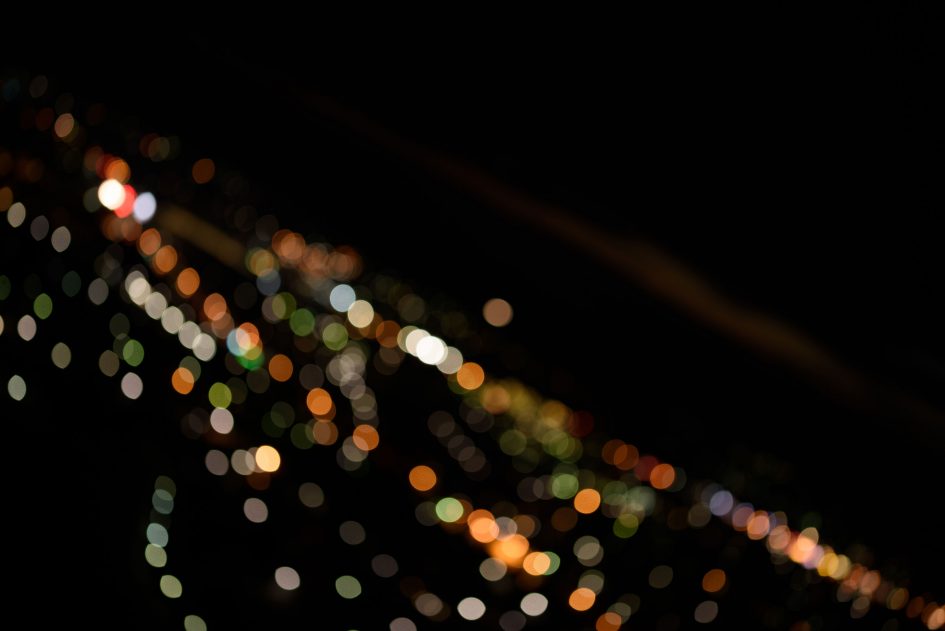
Above: Tamron 90/2.8 VC ii at f2.8; also available at f4.0, f5.6, f8.0

Above: Tamron 90/2.8 VC ii at f2.8; 50% crop from center, APS-C/DX-corner, FF/FX-corner
As the 50% crops above show: The Tamron 90/2.8 Macro VC ii produces a circle of confusion a little smaller than from a 50mm f1.4 lens. It exhibits no onion rings and an even light-distribution across the circle. There’s slight outlining (green around the white circles from loCA) and a clear cat’s-eye effect towards the borders/corners of the sensor but no clipping from the mirror-box.
Following is the Nikon 105/2.8G VR shot only a few minutes apart (also available at f4.0, f5.6, f8.0).

Above: Nikon 105/2.8G VR at f2.8; 50% crop from center, APS-C/DX-corner, FF/FX-corner
The Nikon produces a circle of confusion that is 15% larger than from the Tamron which is hardly decisive and was to be expected from the 105mm focal length. But the Nikon also shows a bit more pronounced outlining and green loCA.
Let’s see how this analysis of out-of-focus point-light sources translates into Bokeh-performance shooting a book-shelf.
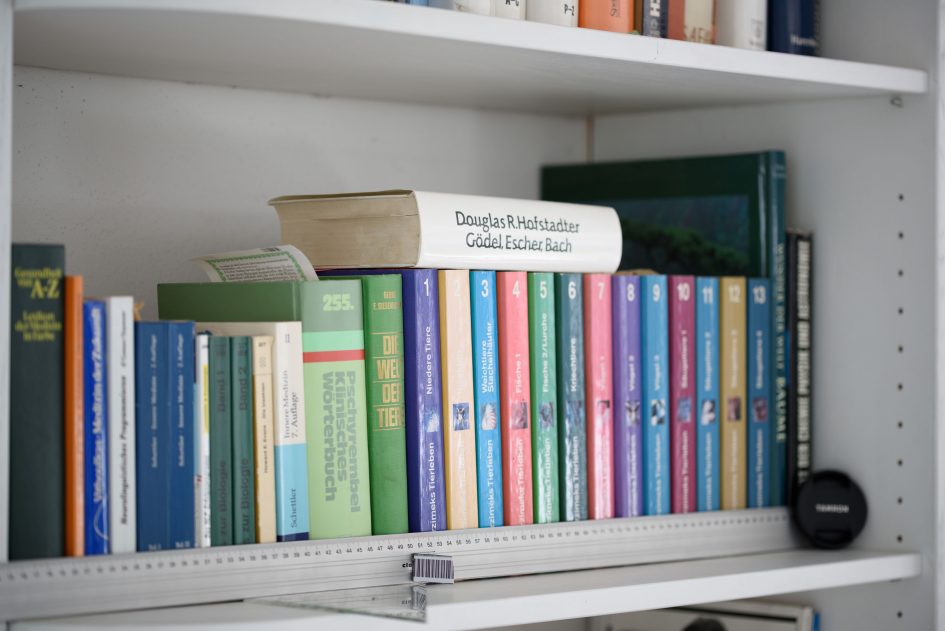
Above: Tamron 90/2.8 VC ii at f3.0; also available at f4.0, f5.6, f8.0, f11

Above: Tamron 90/2.8 VC ii at f3.0; 50% crop from foreground, middle-ground, background
Following is the Nikon 105/2.8G VR at f3.0 (also available at f4.0, f5.6, f8.0).

Above: Nikon 105/2.8G VR at f3.0; 50% crop from foreground, middle-ground, background
When comparing Bokeh of both lenses in this shot the Tamron wins: It renders the softer foreground, shows less green CAs in the middle-ground, and also is a little less nervous than the Nikon in the background. So the Nikon does not translate its bigger Bokeh balls at infinity into an advantage in this shot where the background is just 0.5m behind the plane of sharpest focus.
Flare/ghosting
Catching a strong light-source shining directly into the lens is always a risky business. It could produce strange colorful ghosts-images or reduce contrast considerably through flare and glare. The appearance of flare and ghosting depends on factors like the aperture and the angle of the light hitting the lens. So to judge the proclivity of the Tamron for these artifacts I went through a series of well calculated shots against a strong light source to provoke glare and ghosting.
The results are so-so: With the light inside the image-frame the artifacts are pretty strong. And even when the light was clearly outside the frame but still shining into the lens it provoked some streaking:
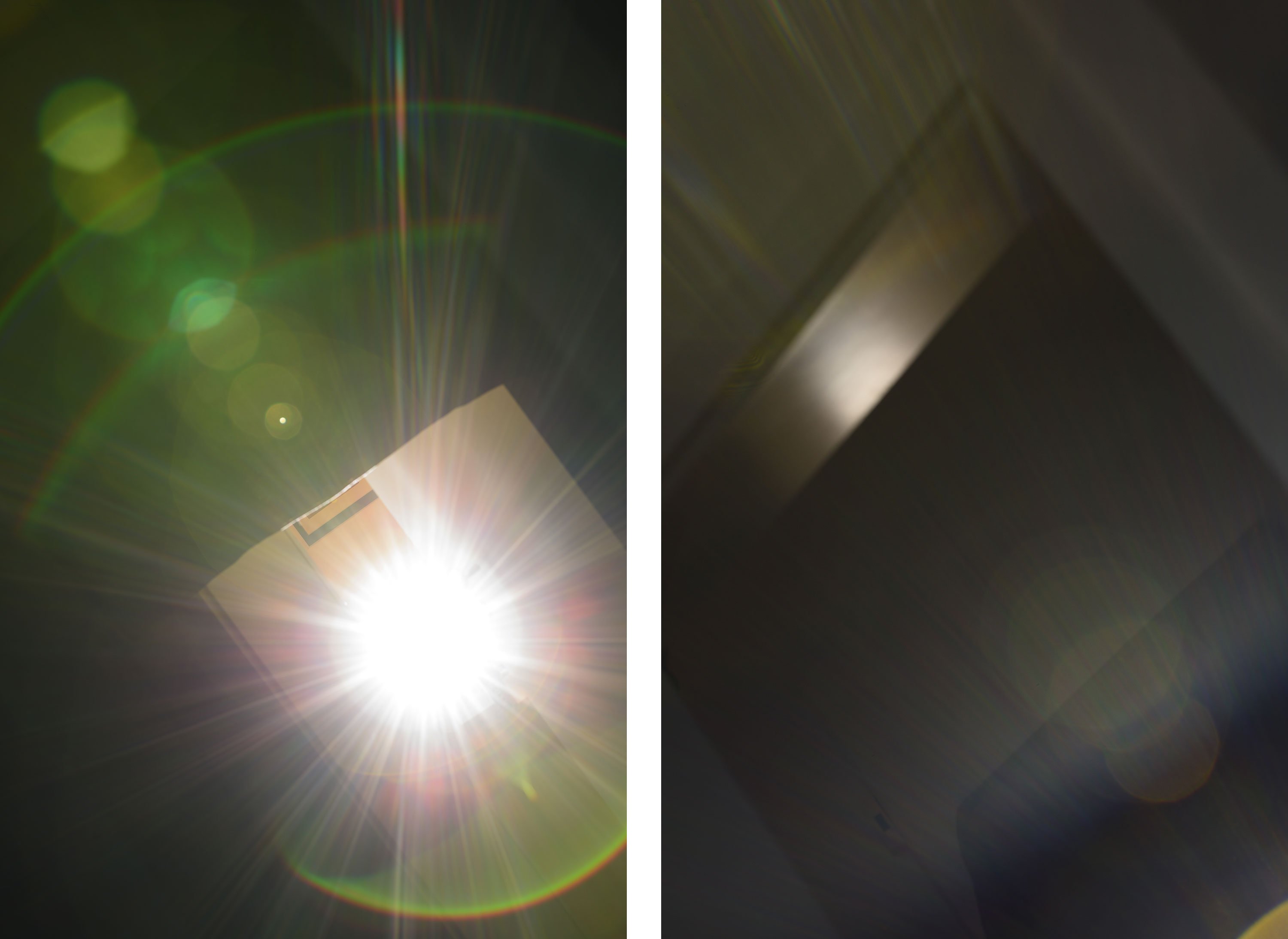
Above: Strong light hitting the Tamron 90/2.8 VC ii at f8.0
Although to be fair: the test-conditions are quite extreme. The older model F004 exhibited the same behavior when the light was inside the frame but produced even uglier streaking when the light was hitting the lens from an oblique angle. The Nikon fared a little better. The lens hood was attached in each of these tests.




